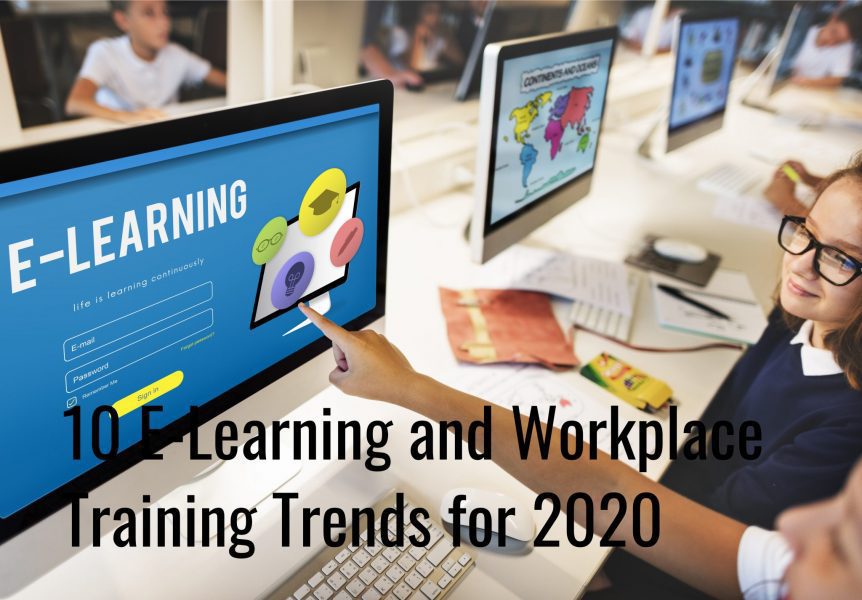10 E-Learning and Workplace Training Trends for 2020
The use of e-learning has developed considerably over recent years. This development has been led by advances in technology as well as the creative skills and innovative thinking of professional e-learning developers who have the ability to put technology advances to the most productive use.
This all leads to new e-learning thinking, processes, and best practices.
Technology doesn’t stand still, however, and neither does the drive for improvement. So, what are the key trends that will influence e-learning and workplace training in 2020 and beyond? Here are 10 to be aware of.
1. Continuing Growth of Immersive E-Learning Tools and Experiences
Immersive technologies like augmented reality (AR), virtual reality (VR), mixed reality (MR), and chatbots, are now much more accessible than they were even 12 months ago. As a result, immersive e-learning experiences are going to become much more popular.
AR, VR, and MR can put learners in the moment with minimal operational or personal risk. Chatbots, meanwhile, help to customise e-learning. For example, you can use a chatbot to give learners the opportunity to get further information on topics or points they don’t fully understand.
2. Use of E-Learning to Improve Staff Retention
Many industries in Dubai and elsewhere are suffering from skills shortages. As a result, staff retention is now a top priority for many businesses. In other words, when they get good staff, they do everything they can to keep them.
One staff retention strategy that is becoming increasingly popular involves facilitating continuous professional development, i.e. proactively helping employees reach their full potential and achieve their career goals.
E-learning can play an important role in helping workers develop the skills they need.
3. Addition and/or Expansion of Soft Skills Training Courses
Following on from the last point, improving soft skills is a key plank of continuing professional development for many workers. This includes everything from teamwork and communication skills to presentation and skills. Training in these areas is becoming an increasingly important part of overall training strategies for companies in Dubai and beyond.
4. Developing Learning Cultures in Businesses
Sticking with the theme of the above two points, companies in a range of sectors are taking steps to establish learning cultures. This is beneficial for individual professional development, but it also helps businesses in other areas.
Knowledge sharing, for example, reduces risk, improves product and service delivery quality, and raises overall standards in the business.
5. New Efforts to Develop Training that Improves Work-Life Balance
To round off the previous three points, companies are increasingly offering training to employees that isn’t directly related to core areas of their businesses. This is the result of an increasing recognition by employers that an employee’s work-life balance has an influence on workplace performance.
Therefore, more and more businesses now offer training in areas like physical health, workplace mental health, and other topics that can help employees achieve a healthy work-life balance.
6. Increasing Focus on Creating Mobile Learning Experiences
The use of mobile devices in the workplace continues to grow. It makes sense, therefore, that e-learning courses are increasingly being developed with a focus on mobile users. This includes courses that are responsive so can be completed on any device as well as e-learning courses designed specifically for mobile phones
7. Expansion of Social Learning
One criticism of e-learning is that it can sometimes be a solitary experience for learners. For many businesses, this potential downside is outweighed by the benefits of e-learning. However, this doesn’t mean we shouldn’t do everything possible to make e-learning a more social experience.
Social media tools are important in this regard, so are increasingly being incorporated into e-learning modules. This includes everything from social media platform integration to social sharing buttons to the inclusion of chat functionality.
8. Continuing Use of Microlearning
Microlearning has long been recognised as an effective training delivery strategy. The combination of advancing technologies and the increasing adoption of mobile learning means companies now include more microlearning courses in their training libraries than before. This is set to continue.
9.Further Development of Adaptive Learning and Artificial Intelligence in E-Learning
Traditional training, including training delivered via e-learning, is fairly universal. E-learning is more adaptable as there are customisation features you can incorporate that learners can use to make courses more relevant to their personal experience.
Artificial intelligence (AI), however, has the potential to turn all this on its head. Adaptive learning technologies are another more specific type of technology that will become increasingly the norm in training and e-learning.
In other words, algorithmic customisation of e-learning courses that automatically adjusts learning paths based on speed of learning, existing skillsets, development priorities, and more.
10. Improvements in Gamification Elements
Like some of the other items on this list, gamification is nothing new. In fact, almost all good e-learning courses include gamification in some form.
The standard of gamification in e-learning is improving, however, as developers come up with new and innovative gamification ideas that can be quickly and seamlessly implemented with powerful, flexible, and adaptable technological tools.
Therefore, the benefits that learners and companies get from including gamification in e-learning will increase.
More Effective, More Efficient, and More Customised
Innovative training strategies, e-learning development creativity, and new technologies are pushing the training industry forward. The result will be improved courses for learners in all industries as well as improved outcomes for companies, including enhanced return on investment.
